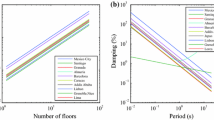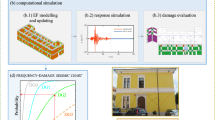Abstract
The fundamental period of structures is a parameter used in structure under design and for evaluating existing structures. Data-driven methods using ambient vibrations have become popular, particularly for the adjustment of empirical relationships applied to building classes. This study presents the results of a survey of ambient vibrations performed in 146 reinforced concrete buildings in the center of Quito (Ecuador). Classical functional forms giving period (T) for height (H) or number of floors (N) are derived and compared with the relationships available in the Ecuadorian seismic design provisions. We highlight variations in the empirical relationships according to soil conditions, but above all according to the date of construction and the historic seismic sequence to which the buildings have been exposed. The cumulative damage effect is finally confirmed by repeating ambient vibration measurements after the 2016 Mw 7.8 Pedernales earthquake located in the subduction zone, about 175 km from Quito. Even with such a long epicentral distance, leading to low macroseismic intensity (IEMS98 = IV), the seismic ground motion of between 0.017 and 0.081 g recorded in Quito reduced the resonant frequency of the buildings tested by between 2 and 13%. This confirms the effect of cumulative damage in reinforced concrete buildings located in seismic zones, even for weak ground motions, and the variability of empirical T/H relationships associated with damage.












Similar content being viewed by others
References
Astorga A, Guéguen P, Kashima T (2018) Nonlinear elasticity observed in buildings during a long sequence of earthquakes. Bull Seismol Soc Am 108(3A):1185–1198
Astorga A, Guéguen P, Rivière J, Kashima T, Johnson PA (2019) Recovery of the resonance frequency of buildings following strong seismic deformation as a proxy for structural health. Struct Health Monit. https://doi.org/10.1177/1475921718820770
ATC3-06 (1978) Tentative provisions for the development of seismic regulations for buildings. Report No. ATC3-06. Applied Technological Council. Palo Alto, Calif
Beauval C, Yepes H, Bakun WH, Egred J, Alvarado A, Singaucho JC (2010) Locations and magnitudes of historical earthquakes in the Sierra of Ecuador (1587–1996). Geophys J Int 181(3):1613–1633
Beauval C, Yepes H, Palacios P, Segovia M, Alvarado A, Font Y et al (2013) An earthquake catalog for seismic hazard assessment in Ecuador. Bull Seismol Soc Am 103(2A):773–786
Beauval C, Marinière J, Laurendeau A, Singaucho JC, Viracucha C, Vallée M et al (2017) Comparison of observed ground-motion attenuation for the 16 April 2016 Mw 7.8 Ecuador megathrust earthquake and its two largest aftershocks with existing ground-motion prediction equations. Seismol Res Lett 88(2A):287–299
Boutin C, Hans S, Ibraim E, Roussillon P (2005) In situ experiments and seismic analysis of existing buildings Part II: seismic integrity threshold. Earthq Eng Struct Dyn 34(12):1531–1546
Brincker R, Ventura C (2015) Introduction to operational modal analysis. Wiley, Hoboken
Brossault MA, Roux P, Guéguen P (2018) The fluctuation–dissipation theorem used as a proxy for damping variations in real engineering structures. Eng Struct 167:65–73
Carder DS (1936) Observed vibrations of buildings. Bull Seismol Soc Am 26(3):245–277
CEN (2004) Eurocode 8: design of structures for earthquake resistance, Part 1: General rules, seismic actions and rules for buildings, Comite Européen de Normalisation, Brussels, Ref No. 1998-1:2004:E.
Chatelain JL, Tucker B, Guillier B, Kaneko F, Yepes H, Fernandez J et al (1999) Earthquake risk management pilot project in Quito. Ecuador GeoJ 49(2):185–196
Chunga K, Livio F, Mulas M, Ochoa-Cornejo F, Besenzon D, Ferrario MF, Michetti AM (2018) Earthquake Ground Effects and Intensity of the 16 April 2016 M w 7.8 Pedernales, Ecuador, Earthquake: implications for the source characterization of large subduction earthquakes. Bull Seismol Soc Am 108(6):3384–3397
Clinton JF, Bradford SC, Heaton TH, Favela J (2006) The observed wander of the natural frequencies in a structure. Bull Seismol Soc Am 96(1):237–257
Cole HA (1968) On-the-line analysis of random vibrations. AIAA Paper 1968; No. 68-288.
Crowley H, Pinho R (2004) Period-height relationship for existing European reinforced concrete buildings. J Earthq Eng 8(spec01):93–119
Crowley H, Pinho R (2010) Revisiting Eurocode 8 formulae for periods of vibration and their employment in linear seismic analysis. Earthq Eng Struct Dyn 39(2):223–235
De Luca F, Verderame GM, Gómez-Martínez F, Pérez-García A (2014) The structural role played by masonry infills on RC building performances after the 2011 Lorca, Spain, earthquake. Bull Earthq Eng 12(5):1999–2026
Dunand F, Ait Meziane Y, Guéguen P, Chatelain JL, Guillier B, Ben Salem R et al (2004) Utilisation du bruit de fond pour l'analyse des dommages des bâtiments de Boumerdes suite au séisme du 21 mai 2003. Mémoires du Service Géologique de l'Algérie 12:177–191
Gallipoli MR, Mucciarelli M, Vona M (2009) Empirical estimate of fundamental frequencies and damping for Italian buildings. Earthq Eng Struct Dyn 38(8):973–988
Gallipoli MR, Mucciarelli M, Šket-Motnikar B, Zupanćić P, Gosar A, Prevolnik S et al (2010) Empirical estimates of dynamic parameters on a large set of European buildings. Bull Earthq Eng 8(3):593–607
Guéguen P, Chatelain JL, Guillier B, Yepes H (2000) An indication of the soil topmost layer response in Quito (Ecuador) using noise H/V spectral ratio. Soil Dyn Earthq Eng 19(2):127–133
Guéguen P, Johnson P, Roux P (2016) Nonlinear dynamics induced in a structure by seismic and environmental loading. J Acoust Soc Am 140(1):582–590
Guéguen P, Langlais M, Garambois S, Voisin C, Douste-Bacqué I (2017) How sensitive are site effects and building response to extreme cold temperature? The case of the Grenoble’s (France) City Hall building. Bull Earthq Eng 15(3):889–906
Guéguen P, Tiganescu A (2018) Consideration of the effects of air temperature on structural health monitoring through traffic light-based decision-making tools. Shock Vib. https://doi.org/10.1155/2018/9258675
Guéguen P, Mercerat ED, Alarcon F (2019) Parametric study on the interpretation of wave velocity obtained by seismic interferometry in beam-like buildings. Bull Seismol Soc Am 109(5):1829–1842. https://doi.org/10.1785/0120190054
Guillier B, Chatelain JL, Tavera H, Perfettini H, Ochoa A, Herrera B (2014) Establishing empirical period formula for RC buildings in Lima, Peru: evidence for the Impact of Both the 1974 Lima earthquake and the application of the Peruvian seismic code on high-rise buildings. Seismol Res Lett 85(6):1308–1315
Goel RK, Chopra AK (1997) Period formulas for moment-resisting frame buildings. J Struct Eng 123(11):1454–1461
Goel RK, Chopra AK (1998) Period formulas for concrete shear wall buildings. J Struct Eng 124(4):426–433
Goretti A, Hutt CM, Hedelund L (2017) Post-earthquake safety evaluation of buildings in Portoviejo, Manabí province, following the Mw7.8 Ecuador earthquake of April 16, 2016. Int J Disaster Risk Reduct 24:271–283
Goulet JA, Michel C, Smith IF (2013) Hybrid probabilities and error-domain structural identification using ambient vibration monitoring. Mech Syst Signal Process 37(1–2):199–212
Laurendeau A, Courboulex F, Bonilla LF, Alvarado A, Naya VA, Guéguen P et al (2017) Low-frequency seismic amplification in the Quito Basin (Ecuador) revealed by Accelerometric recordings of the RENAC network. Bull Seismol Soc Am 107(6):2917–2926
Masi A, Vona M (2010) Experimental and numerical evaluation of the fundamental period of undamaged and damaged RC framed buildings. Bull Earthq Eng 8(3):643–656
Michel C, Guéguen P (2018) Interpretation of the velocity measured in buildings by seismic interferometry based on Timoshenko beam theory under weak and moderate motion. Soil Dyn Earthq Eng 104:131–142. https://doi.org/10.1016/j.soildyn.2017.09.031
Michel C, Guéguen P, Lestuzzi P, Bard PY (2010a) Comparison between seismic vulnerability models and experimental dynamic properties of existing buildings in France. Bull Earthq Eng 8(6):1295–1307
Michel C, Guéguen P, El Arem S, Mazars J, Kotronis P (2010b) Full-scale dynamic response of an RC building under weak seismic motions using earthquake recordings, ambient vibrations and modelling. Earthq Eng Struct Dyn 39(4):419–441
Mikael A, Gueguen P, Bard PY, Roux P, Langlais M (2013) The analysis of long-term frequency and damping wandering in buildings using the random decrement technique. Bull Seismol Soc Am 103(1):236–246
Mucciarelli M, Bianca M, Ditommaso R, Gallipoli MR, Masi A, Milkereit C et al (2009) (2011) Far field damage on RC buildings: the case study of Navelli during the L’Aquila (Italy) seismic sequence. Bull Earthq Eng 9(1):263–283
Nayeri RD, Masri SF, Ghanem RG, Nigbor RL (2008) A novel approach for the structural identification and monitoring of a full-scale 17-story building based on ambient vibration measurements. Smart Mater Struct 17(2):025006
NEC (2002) Norma Ecuatoriana de la Construcción—NEC 2002. Código: Peligro Sísmico -Diseño Sismo Resistente; Código: NEC-SE-DS
NEC (2015) Norma Ecuatoriana de la Construcción—NEC 2015. Código: Peligro Sísmico -Diseño Sismo Resistente; Código: NEC-SE-DS
Perrault M, Gueguen P, Aldea A, Demetriu S (2013) Using experimental data to reduce the single-building sigma of fragility curves: case study of the BRD tower in Bucharest. Romania Earthq Eng Eng Vib 12(4):643–658
Salameh C, Guillier B, Harb J, Cornou C, Bard PY, Voisin C, Mariscal A (2016) Seismic response of Beirut (Lebanon) buildings: instrumental results from ambient vibrations. Bull Earthq Eng 14(10):2705–2730
Stewart JP, Seed RB, Fenves GL (1999) Seismic soil-structure interaction in buildings. II: empirical findings. J Geotech Geoenviron Eng 125(1):38–48
Todorovska MI, Al Rjoub Y (2006) Effects of rainfall on soil–structure system frequency: examples based on poroelasticity and a comparison with full-scale measurements. Soil Dyn Earthq Eng 26(6–7):708–717
Trevlopoulos K, Guéguen P (2016) Period elongation-based framework for operative assessment of the variation of seismic vulnerability of reinforced concrete buildings during aftershock sequences. Soil Dyn Earthq Eng 84:224–237
Vidal F, Navarro M, Aranda C, Enomoto T (2014) Changes in dynamic characteristics of Lorca RC buildings from pre-and post-earthquake ambient vibration data. Bull Earthq Eng 12(5):2095–2110
Villar-Vega M, Silva V, Crowley H, Yepes C, Tarque N, Acevedo AB et al (2017) Development of a fragility model for the residential building stock in South America. Earthq Spectra 33(2):581–604
Ye L, Kanamori H, Avouac JP, Li L, Cheung KF, Lay T (2016) The 16 April 2016, Mw 7.8 (Ms 7.5) Ecuador earthquake: a quasi-repeat of the 1942 Ms 7.5 earthquake and partial re-rupture of the 1906 Ms 8.6 Colombia-Ecuador earthquake. Earth Planet Sci Lett 454:248–258
Acknowledgements
This work was supported by the French Project REMAKE (Seismic Risk in Ecuador: Mitigation, Anticipation, and Knowledge of Earthquakes, ANR-15-CE04-0004), by the Ecuadorian Project SENPLADES (Generación de capacidades para la difusión de alertas tempranas y para el desarrollo de instrumentos de decisión ante las amenazas sísmicas y volcánicas dirigidos al Sistema nacional de gestión de riesgos), and by a Grant from Labex OSUG@2020 (Investissements d’avenir, ANR10-LABX56). The authors would like to thank Juan Gabriel Barros, and Christian Viracucha for their help with the experimental surveys. We would like to especially thank Juan Carlos Singaucho (IG-EPN) for sharing his knowledge of Ecuadorian regulations and the design of the buildings in Quito.
Author information
Authors and Affiliations
Corresponding author
Additional information
Publisher's Note
Springer Nature remains neutral with regard to jurisdictional claims in published maps and institutional affiliations.
Electronic supplementary material
Below is the link to the electronic supplementary material.
Rights and permissions
About this article
Cite this article
Perrault, M., Guéguen, P., Parra, G. et al. Modification of the data-driven period/height relationship for buildings located in seismic-prone regions such as Quito (Ecuador). Bull Earthquake Eng 18, 3545–3562 (2020). https://doi.org/10.1007/s10518-020-00840-0
Received:
Accepted:
Published:
Issue Date:
DOI: https://doi.org/10.1007/s10518-020-00840-0




